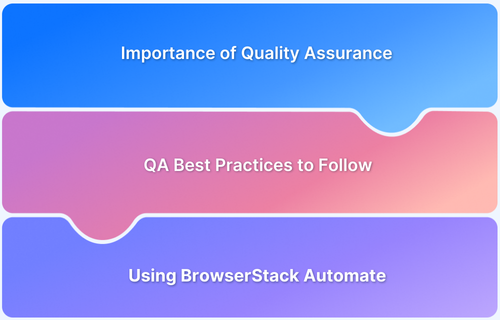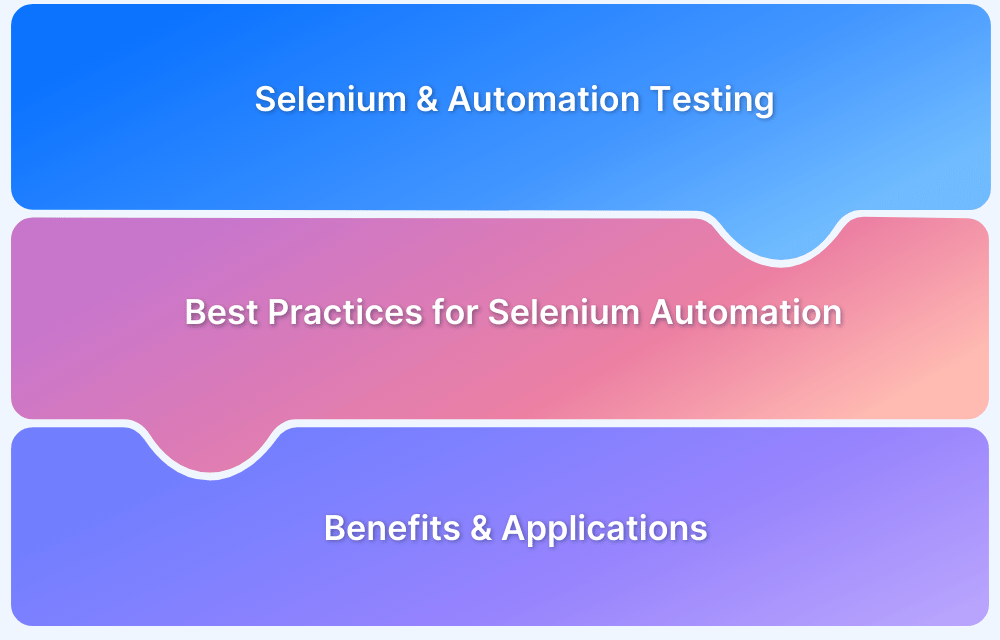QA teams must adopt a broader testing strategy by following a set of best practice to address new challenges such as continuous delivery, evolving user expectations, and changing technologies.
Overview
20 QA Best Practices
- Start Testing Early (Shift Left Testing)
- Automate Repetitive Tests
- Focus on Test Coverage
- Implement Continuous Testing
- Collaborate Closely with Developers and Stakeholders
- Perform Exploratory Testing
- Use Real Devices and Environments
- Prioritize Security Testing
- Analyze Test Results and Metrics
- Maintain and Update Test Scripts
- Test across Multiple Browsers & Devices
- Run Parallel Tests concurrently
- Use Data-Driven Testing
- Implement Performance Testing
- Test in Different Environments
- Focus on Usability Testing
- Perform Compatibility Testing
- Integrate Testing into CI/CD Pipelines
- Use Version Control for Test Scripts
- Conduct Regression Testing
This article explores how QA professionals can broaden their testing strategies by following a set of best practices that facilitates automation, continuous testing, security testing, and more.
What is QA testing?
Quality Assurance (QA) testing refers to the systematic evaluation of software to ensure it meets specified requirements and quality standards. The main objective is to detect defects, enhance product performance, and verify that the software functions as intended in different scenarios.
QA testing helps prevent errors in the development phase. It sees to it that the final product is reliable, secure, and delivers a seamless user experience.
20 QA Best Practices to Follow in 2025
To deliver high-quality software, QA teams must adopt a set of best practices that extend beyond mere functionality testing. Here are 20 essential best practices that can significantly enhance your testing strategy:
1. Start Testing Early (Shift Left Testing)
Follow Shift Left Testing. Get QA involved as early as possible in the development process, during requirement gathering and design stages. This helps identify potential issues before they snowball into costly problems later on. For example, QA can spot unclear requirements or potential integration issues before coding even begins.
By testing early, you minimize the chances of making significant changes later, which can be both time-consuming and expensive. The earlier defects are found, the easier and cheaper they are to fix, making the entire development process more efficient.
2. Automate Repetitive Tests
Automating tests, especially for repetitive tasks like regression, saves time and reduces human error. For example, automating login, adding items to a cart, or completing a checkout ensures these basic functions are tested with every new release.
You can use test automation frameworks like Selenium, Cypress, and tools such as BrowserStack Automate to automate your tests and integrate them into your CI/CD pipeline. This makes it easier to run tests each time new code is committed, offering faster feedback so developers can resolve issues early in the process.
3. Focus on Test Coverage
Make sure your testing covers all aspects of the application, including functional, non-functional (performance, security, usability), and edge cases. A comprehensive test coverage plan ensures your application is thoroughly validated.
Using tools like JaCoCo or Clover to measure test coverage helps ensure all areas of the codebase are tested, reducing the risk of missing critical bugs.
4. Implement Continuous Testing
Continuous testing means running automated tests every time new code is committed. This allows for quick feedback and helps catch issues early, especially when integrated into the CI/CD process. For instance, if a developer commits code that breaks existing functionality, continuous testing will catch it immediately, allowing the team to fix the problem without delaying the release.
By automating tests and integrating them into your CI/CD pipeline, you can achieve faster releases with fewer risks.
Read More: What is Continuous Testing in DevOps
5. Collaborate Closely with Developers and Stakeholders
QA should never work in isolation. Regular communication with developers and product managers helps align the team on the product’s functionality, catch issues early, and ensure the product meets business goals. Collaborating closely can also help identify potential security or performance issues early in development, rather than after release.
Incorporating BDD (Behavior-Driven Development) practices enhances this collaboration. With BDD, testers, developers, and stakeholders work together to define features in terms of user behavior and expected outcomes.
This approach also helps identify potential security or performance issues early in the development cycle, rather than after the product has been released.
6. Perform Exploratory Testing
While automation is essential, testers should also engage in exploratory testing. This approach allows them to use their creativity and intuition to uncover issues that automated scripts may miss. For example, testers might try unexpected interactions or explore complex user journeys to discover hidden defects.
Exploratory testing can often reveal issues that automated scripts miss, especially in real-world usage scenarios where human intuition plays a critical role.
7. Use Real Devices and Environments
Testing on real devices and browsers ensures that your app works as expected under real-world conditions. Tools like BrowserStack Real Device Cloud allows you to access 3500+ real devices for testing across multiple platforms and configurations.
For example, performance can vary on mobile devices depending on hardware specs and network conditions. Testing on real devices provides accurate insights into your app’s performance and usability in various environments.
8. Prioritize Security Testing
Security should always be a top priority. Incorporate security tests such as penetration testing, vulnerability scanning, and static code analysis into your strategy. For example, tests for SQL injection or cross-site scripting (XSS) are critical for preventing data breaches and security risks.
Integrating security testing early helps mitigate risks and ensures your app complies with data protection standards.
9. Analyze Test Results and Metrics
Regularly reviewing testing metrics such as test pass rates, defect density, and test execution times is essential for identifying trends and areas for improvement. By using data-driven decision-making, you can optimize your testing efforts. For example, if certain code branches consistently fail, this points to a quality issue that needs attention.
Metrics also help prioritize testing efforts by identifying the areas of the application that require more focus.
10. Maintain and Update Test Scripts
As your product evolves, so should your test scripts. Regularly updating your automated tests ensures they remain in sync with the current version of the application. For instance, when a new feature is added, the corresponding test scripts should be updated to cover this change.
Maintaining up-to-date test scripts ensures accurate results and prevents false positives or negatives in your testing.
11. Test across Multiple Browsers & Devices
To ensure a consistent user experience, your application must work well across different browsers. Browsers like Chrome, Firefox, Safari, and Edge can interpret the same code differently, leading to rendering issues, layout problems, or broken functionality. For example, a web app might look great in Chrome but experience layout issues in Internet Explorer.
With the variety of devices available today, it’s essential to ensure that your app works smoothly across all of them. Devices differ in screen sizes, operating systems, processing power, and network conditions, which can all impact app performance. For example, a mobile app may work fine on a high-end smartphone but may run slower on an older model.
12. Run Parallel Tests concurrently
Parallel testing can help speed up the testing process. Running tests across multiple devices and browsers combinations, simultaneously allows you to quickly identify device-specific issues.
BrowserStack Automate can help run automated tests parallelly on different browsers and devices simultaneously for faster test results using its Cloud Selenium Grid.
13. Use Data-Driven Testing
With data driven testing, you can run tests with different sets of input data to cover a wider range of scenarios. This helps ensure the robustness of the application. For example, a login feature could be tested with multiple combinations of usernames and passwords to check how it handles various input conditions.
This method also helps uncover edge cases that might not be immediately obvious, ensuring more comprehensive test coverage.
14. Implement Performance Testing
Performance testing ensures that your app can handle the expected load and scale. Use Performance Testing Tools to simulate various conditions to test scalability, load, and stress. For instance, you might simulate thousands of users to see how your app performs under pressure.
Performance testing helps identify bottlenecks and optimizes your application’s scalability under heavy loads.
15. Test in Different Environments
Testing across various environments, different operating systems, hardware configurations, and network conditions is essential. For example, a web app might behave differently on Windows, macOS, and Linux, or may perform more slowly on a 3G network compared to Wi-Fi.
Testing across these environments ensures your app works seamlessly, regardless of how or where it’s accessed.
16. Focus on Usability Testing
Usability testing ensures that your application is user-friendly and offers a smooth experience. Regular usability testing helps uncover pain points in the user interface (UI) or interaction flow. For example, testing the checkout process can highlight barriers that might cause users to abandon their carts.
Enhancing usability can lead to better user satisfaction and increased retention.
17. Perform Compatibility Testing
Test your software across various operating systems, devices, browsers, and network conditions to ensure it behaves consistently across platforms. Platforms like BrowserStack make cross-browser and cross-device testing easier, helping you catch compatibility issues early in development.
For example, an app may work fine on a desktop but behave differently on mobile devices. Compatibility testing ensures such discrepancies are addressed early.
18. Integrate Testing into CI/CD Pipelines
Integrating testing into your CI/CD pipelines ensures that tests are automatically run whenever new code is committed. This minimizes bottlenecks and speeds up the feedback loop.
For example, Automation Testing Tool like BrowserStack easily integrates with popular CI/CD tools ensuring smooth test execution within your existing CI/CD pipeline.
Integration of BrowserStack Automate with CICD Tools
Jenkins or GitLab CI can automatically trigger tests when new code is pushed, providing immediate feedback for the team to resolve issues quickly.
Automating tests within the CI/CD pipeline allows for faster releases without compromising quality.
19. Use Version Control for Test Scripts
Just like application code, test scripts should be version-controlled. Tools like Git help you manage test scripts, collaborate effectively, and track changes. Version control ensures changes to test scripts are documented, and you can revert to previous versions if needed.
This practice maintains the integrity of automated test suites and ensures consistency throughout different test cycles.
20. Conduct Regression Testing
Regression testing is essential to ensure that new changes don’t break existing functionality. Automating regression tests allows you to run them quickly and frequently to verify that the core functions remain intact. For example, after adding a new feature, running the regression suite ensures nothing else has been unintentionally broken.
Automating regression testing helps maintain your app’s stability, even as new code is integrated continuously.
Why use BrowserStack Automate for Test Automation?
BrowserStack Automate is an industry-leading platform that allows QA teams to run automated tests across a wide variety of browsers, devices, and operating systems. It eliminates the need for complex infrastructure setup and provides scalable, cloud-based test environments.
With BrowserStack Automate, QA teams can accelerate testing, increase coverage, and improve overall product quality while reducing the overhead of managing complex test environments.
Here are some of the key features offered by BrowserStack Automate:
- Cross-Browser and Cross-Device Testing: Test on real devices and browsers without maintaining multiple physical setups.
- Parallel Testing: Run tests in parallel across multiple configurations to speed up test execution and reduce feedback cycles.
- Seamless Integration: Easily integrates with popular test automation tools like Selenium, Cypress, and Appium, ensuring smooth test execution within your existing CI/CD pipeline.
- Real user conditions: Test on real devices, ensuring your app performs as it would in the hands of actual users, not emulators.
Emerging Trends in Software Quality Assurance
Here are some emerging trends in QA software testing in 2025:
Emerging QA Trends
- AI-driven testing
- Shift-Left and Shift Right Testing
- Low-Code Test Automation
- AI-driven testing: AL and ML are helping in automating test case generation, visual testing, defect prediction and more. AI-powered testing tools like BrowserStack are prime examples enhancing visual testing and self-healing test automation through AI.
- Shift-Left vs Shift Right Testing: Shift left adopts testing early in the development lifecycle via CI/CD pipelines while shift-right monitors and tests in production via observability tools.
- Low-Code Test Automation: Today testing platforms help QAs with lesser technical know-how to create automated tests with drag and drop interfaces.
Conclusion
By adopting practices like test automation, continuous testing, and integrating tools like BrowserStack Automate, QA teams can ensure more efficient testing, faster feedback, and a higher quality product.
Know what to automate, what tools to use, and how to create good test cases are among the most valuable quality assurance methods and practices in existence.
QAs should also be knowledgeable about tools available in the market and how they can best serve the organization’s needs. For example.
BrowserStack offers a cloud Selenium grid of 3500+ real browsers and devices for automated Selenium testing. The devices and browsers are also available for automated app testing.
The QA best practices described above are instrumental in delivering high quality software. However, each of these practices must follow one basic rule – test on real devices and access real user conditions. Customers will access and use websites and apps on real devices. Hence, there is no substitute for real devices as the testing environment.





